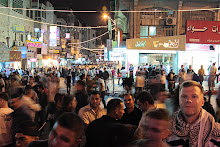I think in my hyperverbosity (my spell-check is telling me that I made up that word, and if so, hooray!) in my questions for Galit Hasan-Rokem expresses a lot of my response to the readings for today, and I don't want to repeat myself too much here.
So I'll talk a bit about recent history and its absence from narratives about Jerusalem.
Like we noticed in Armstrong, it seems that the recent history of Israel/Palestine is often given short shrift: the ancient history, with its religious monuments and milestones, takes up much of our understanding of the region and the current situation. Alternatively, we think about the wars of the 20th century--1948, the Suez Crisis, the Six Days War, 1973, the invasion of south Lebanon, the (first) Intifadeh...and, more recently, the Al-Aqsa Intifadeh, 2006, and Operation: Cast Lead.
What's lost is much of the history during the reconciliations and negotiations of the 1990s. It's as if history didn't happen when there was hope and potential for a peaceful resolution. When the 1990s do get mentioned, it's often in the context of obstacles to the peace process--cafe & bus bombings, settlement construction--as if history is only made up of a series of "flashbulb memories" and spinning newspaper headlines.
Which is why Suad Amiry's vignettes are so critical to understanding not just the lives of Palestinians under occupation (and during closure), but this portion of "missing" history. As an aside, it really threw me off-balance, reading Amiry and recognizing landmarks and roads in Ram'allah.
What is most important is that Amiry is filling in the gaps in the dominant narratives of Israel/Palestine--not just the gaps in history, "filling up" the void of the 1990s, but also "filling in" the void of what people's lives were like--particularly Palestinian lives--on a day-to-day basis.
Sunday, May 8, 2011
Subscribe to:
Post Comments (Atom)


No comments:
Post a Comment